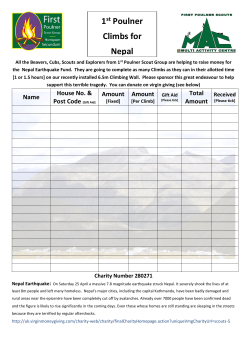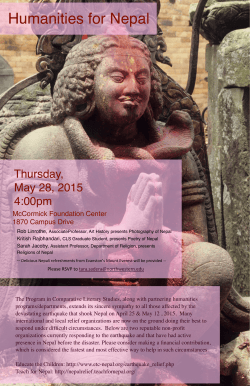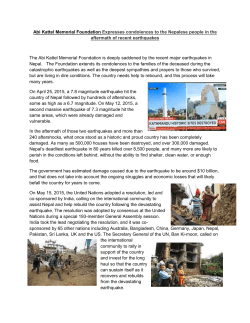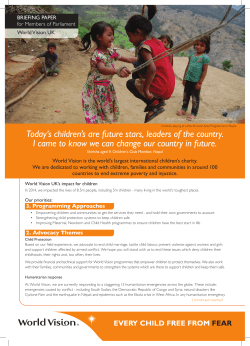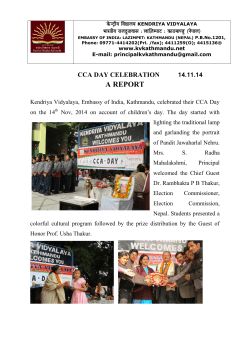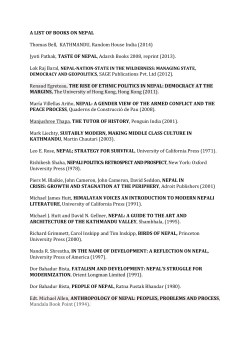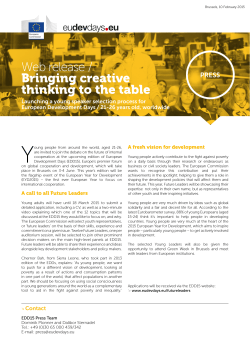
MGD Goal 2
On 8-9 April 2015 in Bangkok, Thailand Organized by APCTT, STI and RIS Presented by Prof. Dr. Ram Chandra Dhakal Executive Director, Centre for Economic Development and Administrative(CEDA), Tribhuvan University 4/14/2015 1 4/14/2015 2 Nepal Lies between two big countries China and India. It is a land locked Country. Total land area is 1,47,181 sq. km. Land area is 143351 sq. km. Water covered area is 3830 sq.km. it is Divided into three zones Viz Three geographical region Terai, Hill & Mountain. Snow Covered High Himalayas (Mountain) ,15% of total area. Hilly region including long terraces & fertile valleys, 68% Sub-tropical plain Region (Terai), 17%. Land elevation from 70 m. to 8848 m (Mt. Everest) from mean sea level. 4/14/2015 3 2005/06 2006/07 2007/08 2008/09 2009/10 2010/11 2011/12 2012/13 2013/14 Average Agriculture Non-agriculture Industry Service Economic growth 2004/05 Fiscal Year 3.5 3.2 3.0 3.3 3.2 1.8 5.3 4.5 5.6 3.7 1.0 4.4 3.9 4.5 2.8 5.8 5.9 1.7 7.3 5.8 3.0 4.3 -0.6 6.0 3.9 2.0 5.4 4.0 5.8 4.3 4.5 3.6 4.3 3.4 3.8 4.6 4.5 3.0 5.0 4.6 1.1 4.6 2.5 5.2 3.5 4.7 5.3 2.7 6.1 5.2 3.2 4.7 2.9 5.2 4.1 4/14/2015 4 4/14/2015 5 4/14/2015 6 4/14/2015 7 4/14/2015 8 Date Competitiveness Ranking Competitiveness Index 2014 117 3.66 2013 125 3.49 2012 125 3.47 2011 130 3.34 2010 125 3.34 2009 126 3.37 2008 114 3.38 2007 104 3.45 4/14/2015 9 4/14/2015 10 Note:1 US$=NRs 100 around 4/14/2015 11 4/14/2015 12 Poverty Headcount Index refers to the proportion of population, to the total population, who are living below the poverty line. Poverty Gap Index refers to the measurement of gap between poverty line and the average number of people living below the poverty line. Squared poverty Gap Index refers to disparity status among the poor. Likewise, Gini Index reflects the uneven distribution of income among the people. 4/14/2015 13 MGD Goal-1(Eradicate extreme poverty and hunger): Population ratio with less than one dollar a day income is 16.4% (progress till 2012/13) and the target for 2015 is 17% Population ratio remaining below daily national poverty line is 23.8% (progress till 2012/13) and target for 2015 is 21%. Ratio of population employed at less than one dollar a day is 22% (progress till 2010) and target for 2015 is 17%. Population with food less than the minimum requirement 15.7% (progress till 2012/13) and target for 2015 is 25%. Underweight Children of (6-59 months) age group 28.8 % (progress till 2012/13) and target for 2015 is 29%. Children of age group (6-59months) with stunted growth 40.5% (progress till 2012/13) and target for 2015 is 30%. 4/14/2015 14 MGD Goal 2 (Achieve universal primary education) achievement and targets are as follow: Net Enrollment Rate at Primary education Level is 95.3% (progress till 2012/13) and the target for 2015 is 100%. Ratio of students enrolled in grade one and continuing to grade 5 is 84.2 % (progress till 2012/13) and the target for 2015 is 100%. Literacy rate of women and men of age group (15-24 years) is 86.6% (progress till 2012/13) and the target for 2015 is 100%. 4/14/2015 15 MGD Goal 3(Promote gender equality and empower women): Ratio of Primary Level Boy and Girl Students was 1.02 (progress till 2012/13) and the target for 2015 is 1. Ratio of Secondary Level Boy and Girl Students was 0.99 (progress till 2012/13) and the target for 2015 is 1. Ratio of Boy and Girl Students at Higher Education was 0.63 (progress till 2010) and the target for 2015 is 1. Literacy rate of women and men of age group (15 and above years) for male was 71.6 % and for female was 44.5% (progress till 2012/13) and the target for 2015 is 1. 4/14/2015 16 MGD Goal 4( Reduce child mortality): Children below the age of one year vaccinated against measles was 85.6% (2011) and target for 2015 is 90%. Child mortality rate below 5 years of age (per 1000 live births) was 54 and target for 2015 is 54(38). Infant mortality rate (per 1000 live births) was 46(2011) and target for 2015 is 36. MGD Goal 5 (Improve maternal health): Maternal mortality ratio (per 100,000 live births) was 170 (2012/13) and target for 2015 is 213(134). Percent of women giving birth with help of Skilled Health Worker was 50 (2012/13) and target for 2015 is 60. 4/14/2015 17 MGD Goal 6 (Combat HIV/AIDS, malaria and other diseases: Age Group between 15-49 with HIV/AIDS Infection was 0.12 % (2012/13) and target for 2015 is halt and reverse the trend. Infected with Malaria ( per 1000 population) was 3.28% (2012/13) and target for 2015 is halt and reverse the trend. Tuberculosis prevalence rate (Per 100,000 population) was 238 and target for 2015 is halt and reverse the trend. Mortality rate from TB (Per 100,000 population) was 21 (2012/13) and target for 2015 is halt and reverse the trend. 4/14/2015 18 MGD Goal 7(Ensure environmental sustainability): Forest Covered Area (%) was 39.6 (2012/13) and target for 2015 is 40. Population with access to sustainable water source (%) was 85 (2012/13) and target for 2015 is 73. Population with sustainable access to improved sanitation (%) was 62 (2012/13) and target for 2015 is 80. 4/14/2015 19 Poverty Headcount Index Poverty gap index Squared Poverty Gap Index 1995/9 2003/ 6 04 1995/ 96 1995/ 96 2009/ 10 2003/ 04 2009/ 10 2003/ 04 2009/ 10 Nepal 41.76 30.85 25.16 11.75 7.60 5.43 4.67 2.70 1.81 21.55 6.54 2.20 3.19 2.65 0.70 1.01 Rura l 43.27 34.62 27.43 12.14 8.50 5.96 4.83 3.10 2.00 Urban 9.55 15.46 4/14/2015 20 The Poverty Alleviation Fund has been conducting demand-led programs in line with five (5) guiding principles namely, I. II. III. IV. V. Antondaya- targeted to the poor, Social inclusion, Transparency, Demand program, and Through the mechanism of direct fund flow to the communities. 4/14/2015 21 Programs are being implemented through formation of Community Organizations (COs) and their institutional development with the objective of ensuring full representation of the poor communities for implementing the community owned programs. The Fund has been collaborating with various Support Organization (SOs) including local bodies, NGOs, COs, and private institutions to provide necessary support to the communities for social mobilization 4/14/2015 22 Development of community-based approaches and management models of rural infrastructure are key for ensuring sustainability; The human rights based approach has been a part of water and sanitation interventions since the beginning, manifested through mainstreaming of gender and social inclusion by step-by-step approach and working in the most remote and poorest areas; The provision of support to the GoN in developing decentralized working and funding modalities based on self-governance build strong ownership and ensure accountability and transparency; The introduction of appropriate technologies in the sector, for example for rainwater harvesting and arsenic mitigation, is well adjusted for local conditions 4/14/2015 23 Size of population in current census is around 27 Million. 500,000 youth are introducing annually in labour force. In average 1500 youth are going each day to abroad to search work/job. Nepal is planning for upgrading from LDCs to developing countries by 2022 that requires double digit economic growth rate but the average annual growth rate for the past 10 years it has been 4.1 % only. 4/14/2015 24 In agriculture around two-third population is employed and its contribution in GDP is around one-third but its growth rate is 3.2 %. Saving is only 9 % of GDP that supplies low investment gives low income and corresponding low saving. Political instability creates disincentive for FDI, in this context the government policy for investment does not work properly. Around half share contributes from service sector and only 15% of GDP from industry. 4/14/2015 25 Declining the poverty line and current it is 23.8% but the poverty intensity has remained higher, gap between rich and poor is still remains wide. Remittance inflow is increasing due to increase in number of labour in abroad for foreign employment amid the absence of adequate employment opportunities in domestic labour market. However, the population growth rate is 1.35 % in last census(2011)while it was 2.24% in 2001. 4/14/2015 26 Nepal has achieved important progress in the past few years, with increased political stability and substantial gains made in reducing poverty and expanding access to services. However, economic growth has been modest compared to its neighbours and the economy - highly dependent on remittances - lacks dynamism. Nepal needs a new economic model to achieve faster and sustained growth as well as further improvements in human development and poverty outcomes. Investment, Infrastructure, and Inclusion. Investment is the bedrock of a sustainable growth model but in Nepal, the state, firms and households critically under-invest. 4/14/2015 27 In order to unlock investment as well as to expand access to services and opportunities for all, public infrastructure is critical, but Nepal is under-connected and under-powered. Finally, growth alone will not ‘deliver’ continued fast progress on inequality and poverty reduction unless the growth model is calibrated for inclusion, which in turn can help sustain dynamic growth. In short, the overall development challenge for Nepal is to promote faster, sustainable and inclusive growth and lay solid foundations for future prosperity. to make it more resilient to shocks, more efficient in intermediating savings for productive use, and better able to reach those firms and households currently unor under-served. 4/14/2015 28 To remove the obstacles that firms face in setting-up and expanding operations in Nepal by alleviating the regulatory burden on firms, reducing non-wage costs of labor, effectively incentivizing production for export and offering foreign investors easier access to Nepal. To leverage the significant fiscal space that Nepal enjoys and enable better public expenditure management by aligning budgets to policy priorities, boosting utilization and ensuring greater value for each rupee spent. Investment on R& D is very low in Nepal. Infrastructure is central to meeting both investment for growth and inclusion challenges. Nepal’s infrastructural challenges are formidable. Necessary investment would need to address both a quantity and quality deficiency, particularly in transport and energy. 4/14/2015 29 Unlocking Nepal’s hydro-potential: Focusing on core bottlenecks that currently hold back public and private investment will be needed. This includes on a sound financial footing, enhancing the policy framework to provide appropriate incentives to private investors, and enhancing policies for the compensation of affected persons. 4/14/2015 30 Expanding connectivity within Nepal and with its neighbours: This would require improving the efficiency of spending on transport infrastructure through more attention on maintenance and better coordination across implementing agencies, as well as greater focus on transformational interventions, such as the Fast Track (Kathmandu-Terai) project. Improving the supply of water and sanitation services: This would involve a two pronged approach to improve the sustainability of rural water supply schemes and incentivizing urban providers to deliver better services. Higher growth is a necessary but insufficient condition for reducing poverty and inequality at a fast pace. In order to walk the extra mile the program should be inclusive. 4/14/2015 31 Active promotion through inclusive public policies will be needed to reach remaining pockets of deep, entrenched poverty, ensure that opportunities. Not just income- are effectively available to all Nepali and to provide those vulnerable with adequate protection against shocks. 4/14/2015 32 A. B. Boosting agricultural productivity and diversity: Because any gains in the agricultural sector, which accounts for over one third of GDP and employs around three-quarters of Nepal’s population, would immediately and automatically reach the poor. This could be achieved by public initiative to boost cooperation and research in agricultural technologies as well as targeted programs to develop agribusiness and value chains with export potential 4/14/2015 33 Expanding the opportunity set of all Nepalese: Through interventions in the health and education sectors to remove remaining social and economic barriers to access to services and to enhance service quality in order to leverage access gains. Enhancing the poverty impact of social protection programs: By limiting further proliferation of programs, strengthening core administrative systems and developing a program explicitly designed to address poverty and other priority risks and vulnerabilities. Preparing for decentralization: Because the move to a federal state will imply a fundamental administrative restructuring, it is key to ensure that the administrative systems are in place for service delivery to proceed and that the new roles of each level of government are clear and funded. 4/14/2015 34 Commitment of Major Political Parties and Gov of Nepal Develop a competitive and globally integrated economy. Promote export-oriented and import substituting industries, and construct dry ports inside industrial zones itself. Ensure good industrial relations and promote industries to utilize domestic raw materials and generate employment opportunities. Human resources development through technical and scientific education, and integrated skills development training. Employment and production centric double-digit growth and in 15 years times attain self-sufficiency with shared prosperity. Formulate action plan for rapid modernization and commercialization of agriculture sector; develop hydropower and energy with utmost priority and as a national campaign; and develop road, railway, ropeway, airport, canal and large physical infrastructure to achieve double digit growth. 4/14/2015 35 Achieve an average 13.2% growth in industry, hydropower and construction sectors. Raise Nepal’s HDI score to 0.781 from the current 0.462. Ensure two-thirds investments from private sector by attracting domestic and foreign investors. Gradually increase domestic investment to completely substitute foreign loans in 40 years. 4/14/2015 36 Thank You 4/14/2015 37
© Copyright 2025
